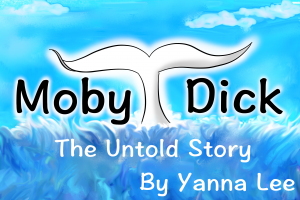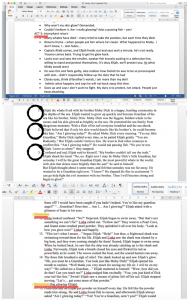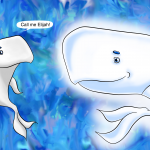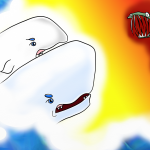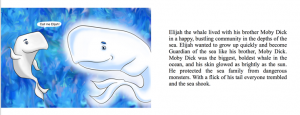My project for this class was to create an illustrated children’s book inspired by Herman Melville’s Moby Dick by writing from the perspective of Moby Dick, the whale. Despite the challenging task of attempting two creative projects simultaneously (writing and illustrating), the two tasks were so complementary that it was impossible to attempt only doing one or the other. All in all, this project was meaningful not only as an experience of creating a project but also in the way it pushed me to think about the project analytically and critically as a response to Melville’s text.
My Finished Project
My completed project is currently a 17-page book (including the cover), with each page consisting of an illustration and text. It came together as follows:
The Text
I initially wrote out the entire plot in prose form and split them into three main acts: The setup, denial, and return. These were then split them into bullet points. During this time countless edits for the plot were made. Afterwards, I typed up actual text for the content of the book, which involved a lot of dialogue, and listed them in number format. Each number was a page number, and consisted of a key plot point, which meant that there would be an accompanying illustration for it. Although I had about 24 sections, due to time constraints I paired up a couple of the sections for an illustration where possible and ended up with 16 pages as a result.
The Illustrations
After completing my plot and text (which was done later than I had planned), I drew out a storyboard on paper before drawing out the illustrations digitally on the program ArtRage. Below you can observe the first 3 illustrations for the book (click to enlarge).
Content/The Story
The story, very simply put, is about the sperm whale Elijah and his brother Moby Dick, who is a Guardian of the sea. As a Guardian, Moby Dick’s white skin glows, and Elijah becomes preoccupied with getting glowing skin in the belief that it will allow him to become a powerful, brave Guardian that everyone looks up to. Moby Dick tries to teach him about true strength not based on physique, but it seems to fly over Elijah’s head. Elijah also gets bullied by Jez and his crew, and this prompts the self-conscious Elijah to run off into danger by running into Ahab. Moby Dick dies saving Elijah, who runs away because of guilt and a decreased sense of worth, but not before Ahab and his crew catch a glimpse of Elijah and believe him to be Moby Dick. Thus begins rumors of Moby Dick’s immortality. After swimming endlessly, Elijah accidentally saves a Lisha, another whale, who affirms him as a Guardian or somebody capable of being one, initiating growth in Elijah. Elijah still feels insecure, and begins to depend on pearl powder to give him an artificial glow and confidence. He becomes stronger and larger as the years pass, but cannot shake off his yearning for home and decides to return. Elijah’s home has become barren in the time Elijah has left, and Ahab has continued hunting for him and took whatever whale he could in his place. This time he has captured Lisha in a net, and as Lisha reminds Elijah that he is more than his skin, Elijah successfully defeats Ahab and knows that protecting somebody is about the courage and responsibility of loving someone rather than a show of brute strength or power. After defeating Ahab Elijah gets his natural glow. Finally, when the fish ask him who he is Elijah states that he is Moby Dick the Guardian, and the legend of Moby Dick is disseminated.
Themes and Discourse with Melville’s Moby Dick
The main themes I explored in my children’s book were true to a coming-of-age genre fit for younger readers – realizing that appearances are not everything and having faith in yourself when you feel discouraged. Aside from this basic premise of self-confidence, however, there are several other points that the story brings out in relation to Melville’s Moby Dick.
Selflessness:
In the story one of the key points is that fact that Elijah sacrifices a desire significant to him (maintaining his artificial appearances) in order to save Lisha. The arc of the story follows Elijah finally growing into the role of a Guardian, whose main purpose is to serve others. In fact, it is when Elijah adjusts his desire to wish to protect somebody other than himself that he begins to glow and become a true Guardian. I felt that this was interesting in relation to Captain Ahab in Moby Dick, who is very self-oriented. He rarely gives a thought to any other character in the text, and is so occupied with himself and his plot for revenge on the whale. Ahab is thus set up as a solitary character, which I wanted to challenge with Elijah, who initially seems to follow a path of solitude before opening up to social interactions and growing.
Anti-Revenge
Similarly, Elijah’s story arc ties into Ahab’s in a much more emotionally accessible way but with different results. While in Moby Dick Ahab is seeking revenge on the whale because of his leg that has been bitten off, in my story Elijah loses his brother to Ahab. As a result, there is a greater sense of gravitas placed on Elijah’s potential revenge plot. However, Elijah is not driven by a desire for revenge in the story. Unlike Ahab, who projects his blame externally, Elijah’s blame is internally placed, as he suffers from guilt and self-condemnation. Thus although ultimately Elijah does defeat Ahab in the story, it is less of a retaliation to Moby Dick’s death but rather an attempt to safeguard what is valuable to Elijah. This is also in essence how Elijah can truly be seen as a “good” stock character and even act as a foil to Ahab.
The Supernatural
Most importantly, one of the central themes in both texts is the preoccupation with the supernatural, namely the idea that the supernatural is a self-imposed or manmade constraint. The supernatural encompasses a series of ideas, such as immortality, fate, and God. Firstly, by creating this children’s book with the whale as the protagonist (with its humanization), I can challenge the idea of the whale as a symbol for God, fate, or even all evil as depicted in Moby Dick. The act of writing this story does this by breaking down the human fear of the unknown that leads people to begin imposing their values or blaming onto it, in this case the supernatural. This is not to say that my story that details Elijah’s path as a Guardian is very clearly all agency with no predestination, but it is also apparent that Elijah overcomes what could have possibly been a self-fulfilling prophecy – belief that he would never become a Guardian because his skin is not glowing (a supernatural trait).
The supernatural trait of immortality is also clearly subverted in the children’s book. It is presented in relation to the ideas of selflessness, the supernatural, but also the human preoccupation with legacy or honor that Ahab shows. We see that Moby Dick is in fact not immortal, and that his brother has continued his legacy, in the process giving up his own glorification – a seemingly counterintuitive act to the character types presented in Moby Dick.
Ultimately these were the points of discourse that remained by the time of completion for my project. Many other possibilities were adjusted or scrapped as I will discuss below.
Successes
Text
Incorporating research/Melville’s Moby Dick
I have found most success in the way that I have incorporated outside sources into the story, and definitely had the most fun piecing my story together with Melville’s Moby Dick for example. After watching a series of whale documentaries on YouTube I saw that for the sperm whale in particular so much emphasis was placed onto the strength of its tail that it was nicknamed the “hand of God.” And from reading Moby Dick I decided to stay true to one of the most defining traits of the whale – its white skin. In Chapter 42, “The Whiteness of the Whale,” I became fixated on the following sections: “Though in many natural objects, whiteness refiningly enhances beauty, as if imparting some special virtue of its own […] there yet lurks an elusive something in the innermost idea of this hue” (42.3). I was inspired to reinterpret the whiteness of the whale in a similar fashion to the way other natural objects are described in the quote, as “refiningly enhance[ing] beauty”, even adding supernatural qualities of a glow to play on this effect. The claim that there “lurks and elusive something in the innermost idea” of the color white emphasized just how much of an abstract or psychologically based impression this came across as, and wished to make use of it. It is through these sources that I was able to begin to define Elijah’s development/growth with two main qualities (as necessary in a simple children’s book): his tail strength and his glowing skin.
Another point that Elijah’s character as an anti-revenge protagonist was inspired by was when Captain Boomer acts as a foil to Ahab in Moby Dick: “There would be great glory in killing him, I know that; and there is a ship-load of precious sperm in him, but, hark ye, he’s best let alone; don’t you think so, Captain?” – glancing at the ivory leg.” (100.36) While he too has lost a limb (an arm) to Moby Dick, he does not let the thought of retaliation overwhelm him, which in turn demonstrates the extent of Ahab’s unhealthy with Moby Dick. This idea was realized as Elijah’s story began to form.
Other notes in Moby Dick about the whale that I took into account included how “some whalemen should go still further in their superstitions; declaring Moby Dick not only ubiquitous, but immortal (for immortality is but ubiquity in time)” (41.13). The idea of the whale being at several places simultaneously and being of an “uncommon bulk” (41.13) also matched up neatly to the section of my plot that involved Elijah’s time away from home and chasing away whalemen.
Naming
Naming was very crucial to this story, and I believe the name making definitely established another interesting layer over the story. Elijah was made based off the biblical context that Ahab seemed to reference. Even in the Bible it is Elijah that rebukes Ahab, and in a sense this children’s book could be seen as a similar form of literary interaction between the characters. Jez, the bully, was named after Queen Jezebel, the wife of Ahab, but I needed to make sure that he was a male, simply because I did not wish for the one bad sea creature in the book to be identified by gender. In order to avoid such misunderstandings, I decided to stay safe by making everybody in the story male, so that readers would not be noticing gender. As for the name “Guardian”, there were other names I had brainstormed such as “The Protectors” or “White Knights”, but “protector” sounded almost too self-explanatory, and “White Knights” seemed to emphasize the color of the whale too much, which would actually be going against the premise of the story. This was how I decided on “Guardian”. And lastly, I was most excited about the transition or renaming of Elijah as Moby Dick the Guardian. It would be the point that made the story fit together with the Moby Dick novel, but it would also come across as an ultimate sacrifice for a whale who had seemed so self-obsessed.
Other successful plot changes
I changed Elijah from being a royalty or king to what seemed like a more defense-based, serving role. If Elijah were some royal bloodline, the story would only seem to elevate the notion of destiny and perhaps even going through with a revenge plot because it is justified, which seemed like an environment where it would be harder for me to control Elijah’s personality as self-conscious. While adjusting the title to “Guardian” did not completely remove such notions of a “rightful place”, it definitely helped tone it down. This also allowed me to not place as much emphasis on a clear dichotomy of good and evil centered on specific figures. While in Moby Dick it was clear that the whale was evil and the end to the whole process of the novel, in my story I didn’t wish for Ahab to be the one man to embody all of the evils in the world. As a result I was able to get Elijah to look into himself more to grow rather than chase after an evil man and succeed (although the result in these two scenarios would look the same).
I also added Elijah’s preoccupation with the self to provide a greater contrast when he would become a true Guardian. This was achieved by having Elijah constantly asking others whether he was glowing, and ultimately start to put artificial powder on himself. There was also the idea of including a mirror, but I felt that this would make Elijah so isolated and lost in the idolization of the object that it would be harder to try and create an opening for him to interact socially albeit for affirmation about his worth.
I also added a sidekick, Lisha, after writing my first draft of the plot, but with more adjustments I began to place more significance plot wise onto him. With Moby Dick gone, I realized I needed another form of external force to similarly encourage Elijah if not remind him of what his brother used to tell him. This is because ultimately it is only when Elijah finds another whale he cares for strongly enough that he is pushed to grow emotionally and physically. Thus in my original plot I had planned for Elijah to be moved by all of the smaller, beaten and worn out fishes trying to protect him when he was being cowardly, but this required much more space and time for relationships between these fish/the sea community and Elijah. Thus I added more depth to Lisha, who would be able to truly connect with Elijah and bring out his Guardian nature. In fact, oftentimes it is because in a sense Lisha seems to have the qualities of a true Guardian himself that Elijah himself becomes one, and this mutual growth is crucial in the plot.
All in all, the biggest success for my plot would be that it is not purely an explanation for Melville’s Moby Dick but a story in its own right, which was one of my biggest worries (as mentioned in my proposal).
Illustrations
Aside from my biggest success being that I was able to complete all of the illustrations I had planned (although my plans adjusted the number midway), I believe what made the illustrations so worthwhile was their ability to make up for much of the content I wasn’t able to include as much into the children’s book for the sake of concision. For example, though it was never specified in the story because it would seem to place emphasis on species, both Jez and Lisha are killer whales. By allowing both good and bad characters to be portrayed in the short span of the story (through illustration) allowed me to prevent stereotypes or generalizations about animals based on appearances.
I was also able to make further references to Moby Dick in the illustrations, examples including the first page where we see Elijah saying “Call me Elijah” in an echo of Moby Dick’s opening lines, “Call me Ishmael”. Also in the illustration where Elijah is fighting Ahab, we can see Ishmael hanging onto a coffin to the left of the page.
Another important part of the illustrations was that it allows better interactions with the readers, who might pay more attention to the artwork. I could show a part of Lisha in the page before he was described, for example, to show that he was in fact watching. Lastly, the illustrations shoe Elijah beginning to glow already as he fights Ahab. This was very important because in staying true to the children’s book form much of the story was written in a third person limited point of view, and describing the specifics of when the glow occurred would stop the flow of the action.
Struggles/Shortcomings
One of the most challenging parts of the plot writing was figuring out Elijah’s acceptance of Moby Dick’s name. I had sought to make this moment quite meaningful in the way that Elijah sacrifices his own glory, and seems to go against norms of elevating yourself. I had also hoped to clarify that Elijah calling himself Moby Dick is in fact just like his superhero name, where he is not losing is sense of self but simply finding another part of himself. However, in a simplified children’s book I struggled with getting this more nuanced idea across. I am slightly worried that it could be misconstrued as Elijah not being confident in himself and hiding behind the glory of his brother.
I also had a very challenging time trying not to stick to technicalities and explaining every single detail. This occurred when I was condensing the story and adjusting the language in order to fit the children’s book genre. For example I was trying to start the story like this: “Both Elijah and Moby were sperm whales, which meant they were the largest, most powerful fish in the whole world. They also had the duty to be guardians of the sea and protect weaker fish. As a symbol of his role as protector, Moby’s skin glowed radiantly. This dazzling skin would be bestowed onto a true protector of the sea. However, trying to set up the premises of being a Guardian and how things came to be made me realize that the book did not begin in a very captivating way. This, however, meant that I needed to forgo certain detailed I had in fact planned out, such as the fact that Moby Dick bites off Ahab’s leg before he dies. But since the focus was on the whales, I could not afford to draw a close up version of Ahab without also making the scene too gruesome. As a result, I also was not able to draw out Ahab, who I had prepared character sketches for.
Other technicalities included how I could not include all the physical traits of the whale in Moby Dick, for example: “peculiar snow-white wrinkled forehead, and a high, pyramidical white hump,” (42.3) “his body was so streaked, and spotted, and marbled with the same shrouded hue,” (42.3) and his “deformed lower jaw” (42.3). I was trying to also portray the harpoons stuck in Elijah as a battle scar of some sorts, maybe even piercings, but this also became too cruel-looking. Thus I toned down my illustrations, despite the content that does not as much. Ultimately I needed to come to terms with the suspension of disbelief or ex machinas that came to play a lot in children’s books. Looking at read along Disney children’s books definitely helped me see how complex stories were condensed. This also meant that I was not able to tie in the plot point that Jez and Lisha were in fact brothers, and show a scene that shows Jez apologizing and asking Elijah to save Lisha.
Looking Forward/Redoing the Project
On the whole this project was so worthwhile and really challenged my creativity and perseverance. I have understood how difficult it is to write for children. Just because seems simplified doesn’t mean the writing is easy. If I could redo the project, or looking forward, I would try to work on writing in a way that shows more than tells, and possibly rework the ending. As for illustrations, while I am satisfied with what I have accomplished in the time frame, there are definitely more illustrations that I could do. I will definitely be spending more time on this and I plan to draw out 7 extra illustrations. I would also want to experiment more with different mediums, since I believe I could have attempted watercolor or acrylic painting if I had had more time for experimentation. I would also add a greater variety of sea creatures for diversity, such as sea urchins, sea horses, jellyfish, squids, and dolphins.
Finally, I will be looking more into the actual creation of this project. I have looked into self-publishing platforms such as Blurb or Kickstarter. Aside from publishing, there are many other avenues for exploration, such as creating a coloring book edition, and an ebook edition with accompanying audio. As for the current format of the book, I believe that the text is too small on the page, and plan to make the text bigger by making it a two-page spread – one illustration and one text. This would be more practical since the illustration doesn’t necessarily interact with the text visually.
I believe that this semester has been a promising start to what could be a much more long-term project and look forward to seeing it through.
Publishing sites:
http://www.blurb.com/sell-through-blurb
